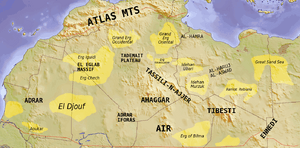Libyan Desert facts for kids
The Libyan Desert is a huge, dry area that makes up the northern and eastern parts of the Sahara Desert. The Sahara is the world's largest hot desert. This special part of the Sahara is mostly found within the country of Libya. It also includes desert areas to the south of what was once called Ancient Libya. The Libyan Desert is known for being one of the driest, toughest, and most isolated places in the entire Sahara. It gets very little rain and is mostly barren land.
Contents
Location and Size
The Libyan Desert covers a massive area in North Africa. It stretches across eastern Libya, western Egypt, and northwestern Sudan. This desert is a significant part of the Sahara, which is the largest hot desert on Earth. It's so big that it's about the size of a country itself! Its vastness makes it one of the most remote places in the world.
Climate and Environment
The weather in the Libyan Desert is extremely harsh. It is one of the driest places on the planet. Rain is very rare here, sometimes not falling for many years. When it does rain, it's often a sudden, heavy downpour that quickly disappears.
Temperatures can be very hot during the day, often reaching over 50°C (122°F) in summer. At night, the desert cools down quickly, sometimes dropping below freezing in winter. This huge difference between day and night temperatures is typical for deserts. The landscape is mostly made up of vast sand dunes, rocky plateaus, and dry riverbeds.
Unique Features
The Libyan Desert has some amazing natural features. One of the most famous is the Great Sand Sea. This is a huge area covered in towering sand dunes that can be hundreds of feet high. These dunes stretch for miles and are constantly shaped by the wind.
Another interesting feature is the Gilf Kebir plateau. This is a large, raised area of sandstone rock. It's known for its ancient rock art, which shows animals and people from thousands of years ago. These paintings give us clues about what life was like in the desert when it was much wetter.
Despite being so dry, there are a few oases scattered across the Libyan Desert. Oases are places where water comes to the surface, allowing plants and sometimes small communities to survive. These green spots are like islands in the vast, sandy ocean.
Exploring This Desert
Because the Libyan Desert is so remote and harsh, it has been explored by very few people. Traveling through it is extremely challenging. Early explorers faced many dangers, including extreme heat, lack of water, and getting lost. Today, special vehicles and navigation tools are needed to cross this difficult terrain. Scientists and adventurers still visit the desert to study its geology, climate, and ancient history.
Images for kids
See also
 In Spanish: Desierto Líbico para niños
In Spanish: Desierto Líbico para niños






